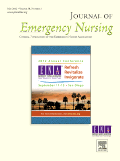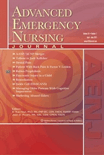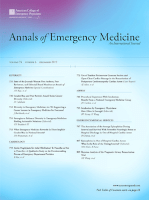
Journal of Emergency Nursing
Scope & Guideline
Transforming Acute Care with Cutting-Edge Research
Introduction
Aims and Scopes
- Emergency Nursing Practice:
The journal emphasizes research focused on the practical aspects of emergency nursing, including assessment, intervention, and patient management in acute care settings. - Workplace Environment and Well-Being:
A significant focus is on the workplace dynamics affecting emergency nurses, including studies on workplace violence, mental health, and strategies to enhance nurse retention and well-being. - Quality Improvement Initiatives:
The journal features articles on quality improvement projects aimed at enhancing clinical practices, workflow efficiency, and patient safety in emergency departments. - Mental Health and Behavioral Health:
Research on mental health issues, including the care of patients with mental health conditions in emergency settings, and the psychological impact on emergency nurses themselves is a core area of focus. - Education and Training:
The journal publishes studies on educational strategies and training programs for emergency nurses, highlighting innovative approaches to enhance clinical competence and patient care. - Emergency Preparedness and Response:
Research addressing the preparedness of emergency departments for public health emergencies and disasters, including the COVID-19 pandemic, is also a key area of interest.
Trending and Emerging
- Workplace Violence and Safety:
There is an increased focus on workplace violence, including studies aimed at understanding its impact on emergency nurses and developing strategies to enhance safety and support. - Mental Health Support for Nurses:
Emerging themes include the mental health and well-being of emergency nurses, with a growing body of research aimed at addressing burnout, moral distress, and resilience in the face of challenging work environments. - Integration of Technology in Care:
The use of technology, such as telehealth services and advanced monitoring systems, is becoming a prominent theme, reflecting the ongoing transformation and modernization of emergency care practices. - Patient-Centered Care Approaches:
Research increasingly emphasizes patient-centered care strategies that consider the holistic needs of patients, including cultural competency and the integration of family presence during care. - Quality Improvement and Evidence-Based Practice:
There is a notable trend towards quality improvement projects that utilize evidence-based practices to enhance patient outcomes, reflecting a commitment to continuous improvement in emergency nursing.
Declining or Waning
- Traditional Acute Care Models:
Research articles focusing solely on traditional acute care models without integrating contemporary challenges, such as telehealth or community-based care, appear to be less common as the field shifts towards more holistic approaches. - Limited Scope of Patient Populations:
There has been a noticeable decrease in studies that focus narrowly on specific patient populations, such as only adult trauma patients, as the journal increasingly embraces broader topics including pediatric, geriatric, and diverse populations. - Infrequent Discussion of Basic Clinical Skills:
Topics centered around basic clinical skills and procedures, while still important, have seen reduced emphasis, likely due to the journal's shift toward advanced practice and innovative care strategies. - Single-Institution Studies:
The prevalence of single-institution studies appears to be declining, as there is a growing preference for multicenter studies that provide more generalized findings applicable across various settings.
Similar Journals

Journal of Emergencies Trauma and Shock
Advancing emergency care through innovative research.The Journal of Emergencies Trauma and Shock, published by Wolters Kluwer Medknow Publications, is a premier open-access journal dedicated to advancing the field of emergency medicine. With an ISSN of 0974-2700 and an E-ISSN of 0974-519X, this journal has been a vital resource since its inception in 2008, providing a platform for original research, reviews, and clinical studies pertinent to trauma and shock management. The journal is recognized for its significant contributions to the field, illustrated by its strong standing as a Q2 journal in Emergency Medicine and ranking #34/109 in Scopus, with a commendable 69th percentile. Based in Mumbai, India, the journal not only reaches local practitioners but also caters to an international audience with its commitment to disseminating high-quality research that influences practice and policy in emergency settings. The publication is especially respected for its innovative approaches and practical findings that inform healthcare professionals on the front lines of trauma care. Researchers, practitioners, and students alike will find invaluable insights and data that help to shape the future of emergency medicine.

Journal of the American College of Emergency Physicians Open
Elevating Standards in Emergency Medicine Education and ResearchJournal of the American College of Emergency Physicians Open is a prominent Open Access journal published by WILEY that has been committed to advancing the field of emergency medicine since its inception in 2020. As a vital resource for researchers, clinicians, and students, this journal aims to disseminate innovative research findings, clinical guidelines, and educational resources that support the rapidly evolving landscape of emergency care. With a solid Q1 ranking in the emergency medicine category and positioned within the top 25 ranks of Scopus’ emergency medicine listings, the journal ensures high visibility and accessibility for critical research. As an open-access publication, it provides unrestricted access to its content, facilitating knowledge sharing and collaboration among professionals globally. The journal's significant impact on the field is reflected in its growing influence, underlining its relevance as an essential platform for advancing emergency medicine practice and research.

AMERICAN JOURNAL OF EMERGENCY MEDICINE
Elevating Standards in Emergency Medical ResearchThe American Journal of Emergency Medicine, published by W B Saunders Co-Elsevier Inc, stands as a premier platform for the dissemination of high-quality research in the field of emergency medicine. With the ISSN 0735-6757 and E-ISSN 1532-8171, this esteemed journal features contributions that shape clinical practices and enhance patient care in urgent medical scenarios. Since its inception in 1983, the journal has garnered a notable Q1 ranking in Emergency Medicine and a Q2 ranking in Medicine (miscellaneous) for 2023, reflecting its significant impact in the field, as denoted by its Scopus rank of 12 out of 109, placing it in the 89th percentile. Researchers and practitioners alike benefit from the rigorous peer-review process, ensuring that only impactful studies are published, even as the journal maintains a non-open access model, allowing for selective availability of pioneering research. By fostering academic dialogue and advancing knowledge, the American Journal of Emergency Medicine plays a crucial role in addressing the dynamic challenges faced by healthcare professionals in emergency settings.

Advanced Emergency Nursing Journal
Shaping the Future of Emergency Medicine TogetherAdvanced Emergency Nursing Journal, published by Lippincott Williams & Wilkins, stands as a key resource within the domains of Emergency Medicine and Emergency Nursing. With a commitment to advancing the field, this journal provides a platform for rigorous research, critical reviews, and innovative practices aimed at enhancing patient care in emergency settings. Though it holds a Q3 ranking in both related categories as per the 2023 metrics, its global reach spans various aspects of emergency care, promising insights that are crucial for both professionals and academics alike. Covering topics from clinical procedures to policy analysis, the journal invites submissions that aim to bridge theory and practice, highlighting the importance of evidence-based approaches in emergency nursing. Researchers, educators, and healthcare practitioners can Find more information and explore their own contributions in a dynamic environment that continuously evolves with the field. Whether you're seeking to stay current with the latest advancements or to publish your findings, this journal is an essential asset for those dedicated to improving care in urgent medical situations.

Clinical and Experimental Emergency Medicine
Advancing emergency care through innovative research.Clinical and Experimental Emergency Medicine, published by the SEOUL KOREAN SOCIETY OF EMERGENCY MEDICINE, is a premier Open Access journal dedicated to advancing knowledge and practice within the fields of emergency medicine and emergency nursing. With an ISSN of 2383-4625 and an E-ISSN of 2383-4625, this journal has established itself prominently in the academic community, achieving a notable Q2 ranking in both Emergency Medicine and Emergency Nursing categories in 2023. The journal is committed to providing highly relevant research, innovative clinical practices, and educational resources that address the urgent and evolving challenges in emergency care. With a vision to foster collaboration among researchers, practitioners, and students, it aims to contribute significantly to the body of knowledge that enhances emergency medical services and improves patient outcomes globally. Accepting submissions and offering Open Access since its inception in 2014, the journal is positioned as a key resource for those dedicated to the advancement of emergency medicine.

Open Access Emergency Medicine
Empowering practitioners with cutting-edge emergency insights.Open Access Emergency Medicine, published by DOVE MEDICAL PRESS LTD, is a premier journal dedicated to the dynamic fields of Emergency Medicine and Emergency Nursing. With its ISSN 1179-1500, this journal has established a notable presence since its inception as an Open Access platform in 2010, offering unrestricted access to high-quality research and innovative practices in the area. As one of the leading journals in its field, it holds a respectable Q2 ranking in both Emergency Medicine and Emergency Nursing categories as of 2023, reflecting its commitment to advancing knowledge and fostering impactful research. The journal is indexed in prestigious databases with solid Scopus rankings, placing it in the 65th percentile for Emergency Medicine and the 64th percentile for Emergency Nursing, ensuring that contributions reach a diverse audience of researchers, practitioners, and students worldwide. With its focus on contemporary issues, this journal serves as an essential resource for the continual growth and development of emergency health services.

Eurasian Journal of Emergency Medicine
Elevating standards in emergency care through shared insights.Eurasian Journal of Emergency Medicine is a premier journal dedicated to advancing the field of emergency medicine. Published by GALENOS PUBL HOUSE, this renowned open-access journal has been at the forefront of disseminating critical research and innovative practices since its inception in 2003. With an ISSN of 2149-5807 and an E-ISSN of 2149-6048, it provides a platform for researchers, professionals, and students to share their findings and enhance their understanding of emergency medical practices. The journal's commitment to open access ensures that vital knowledge and research are available to a global audience, promoting collaboration and development within the field. As a valuable resource, the Eurasian Journal of Emergency Medicine plays a pivotal role in shaping contemporary emergency care, addressing pressing issues, and exploring advancements that benefit practitioners and patients alike.

Frontiers in Emergency Medicine
Transforming challenges into solutions in emergency medicine.Frontiers in Emergency Medicine, published by Tehran University of Medical Sciences, stands as an essential open-access platform dedicated to advancing research and practice in the diverse fields of emergency medicine, nursing, and medical services. With a focus on publishing high-quality studies that address the emerging challenges in prehospital and emergency care settings, this journal has rapidly gained recognition since its inception in 2021. The journal's current Scopus rankings place it favorably within the top quartiles for emergency medical services and emergency nursing, making it a valuable resource for researchers and practitioners aiming to enhance patient care and operational efficiency in emergency contexts. The journal encourages submissions that explore innovative practices, clinical outcomes, and policy developments in emergency medicine, promising accessibility and visibility for authors through its open-access model. Located in Iran, Frontiers in Emergency Medicine not only serves the regional community but also aspires to impact the global discourse in emergency healthcare.

JOURNAL OF EMERGENCY MEDICINE
Exploring contemporary challenges in emergency healthcare.The JOURNAL OF EMERGENCY MEDICINE, published by Elsevier Science Inc, is a premier peer-reviewed journal dedicated to advancing the field of emergency medicine. Since its inception in 1983, this journal has served as an essential resource for researchers, clinicians, and students, contributing significantly to evidence-based practices and innovations in the emergency medical landscape. With an impressive ranking of 43 out of 109 in the field of Emergency Medicine according to Scopus, and a current impact factor placing it in the Q2 quartile, this publication is recognized for its rigorous scholarly content and relevance in tackling contemporary issues in emergency care. Although it does not offer open access, the journal remains widely respected for its contribution to the global emergency medicine community, fostering new ideas and discussions that drive the field forward. For those seeking to stay at the forefront of emergency medical research, the JOURNAL OF EMERGENCY MEDICINE is an invaluable addition to your academic endeavors.

ANNALS OF EMERGENCY MEDICINE
Your Gateway to Essential Emergency Medicine DiscoveriesANNALS OF EMERGENCY MEDICINE is a leading peer-reviewed journal dedicated to the advancement of emergency medicine, published by MOSBY-ELSEVIER. With an impressive impact factor and a prestigious ranking of Q1 in the field, this journal serves as an essential platform for disseminating innovative research findings, clinical practices, and policy developments within emergency medicine. Recognized for its high-quality contributions, it ranks #6 out of 109 in Scopus's Emergency Medicine category, placing it in the top 6% of journals in the field. Since its inception in 1980, ANNALS OF EMERGENCY MEDICINE has consistently provided valuable insights to researchers, practitioners, and students, fostering a deeper understanding of emergency care challenges and solutions. While the journal is not open access, it remains a cornerstone for those seeking to stay at the forefront of emergency medicine advancements, providing access to critical research within the field.